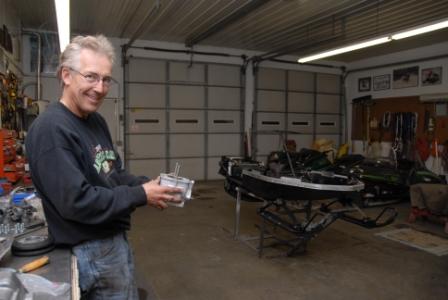So what’s been happening with Brian Nelson’s three-sled Vintage I-500 project since I posted THIS FIRST STORY?
A lot. But a project of this magnitude isn’t completed overnight.
In fact, I’ve spent three ENTIRE days at Brian’s shop since the first story was posted, working on the 1979 Arctic Cat el tigre Cross-Country that I will run in the upcoming USCC I-500 race, while Brian has split his time between this and the other two ’79 Cross-Country tigers that he and Joey Hallstrom will run.
And I’d say that we’re half done. Maybe.
Thirty-year-old vintage sleds need a little TLC before they’re going to go 170 miles in a cross-country race. Some of the work required on these sleds isn’t so glamorous, like grinding off rusted bolts and drilling out loose rivets.
Seemingly small jobs like removing the old snow flap can turn into 30-minute sessions simply because the bolts have corroded and need to be ground off.
Plus, we’re talking Brian-Nelson-prepping, which is WAY more detailed and time consuming than probably most people would do.
Let’s face it, as a former professional Team Arctic racer and engineer, Nelson simply knows more about what can and should be done to race-prep a snowmobile, than most of us would ever imagine. For instance, extra welds on the ski mounts, more robust hardware and tightened tolerances at every pivot.
That, coupled with the fact that his approach to racing has always been one of complete, leave-no-part-unchecked focus, he’s bound to spend more time and effort on his sleds than most.
Nelson wants every shaft cleaned, every bearing replaced, every steel component repainted, every bolt to be new, and every shock to be a FOX.
Tricks of the trade? Yep, for instance, the cross-shaft that supports the front torsion springs for the rear suspension is mounted separately from the actual suspension, and its bolt locations are inside the bellypan near the footholds. Not too convenient, especially if you need to remove/access it in something other than a well-lit, heated shop.
So Nelson drills a 1.5-in. hole in the bellypan to easily access the bolt/shaft with a socket wrench. Smart.
Know this about Nelson: He’ll share with ANYONE his tricks, ideas and advice about building an Arctic Cat (or anything else) to go racing. His strongest hope for this year’s vintage I-500 race is that as many people will participate.
And there’s a personal element to it as well, especially for the ’78 (kitted) el tigre and the production 1979 CC el tigre: He was one of a handful of people who designed and built them, and his greatest satisfaction will be seeing some of those sleds on the starting line (and at the finish!) in Thief River Falls.
This is the ’79 Arctic Cat CC el tigre that I plan to race. I’m returning to Nelson’s shop in Spicer, Minn., this weekend to do some more work, like installing the engine, hooking up the hydraulic brake, placing the seat and such. But there is still much to do, like studding the track, rebuilding the clutches, and probably 10 other “issues” that will surface during the day.
Maybe this time I won’t accidentally drill a hole into one of the tunnel-mounted heat exchangers, like I did a couple weeks ago? Smart moves like that can add extra work, and a few choice words.
It’s been an absolute blast to once again work alongside Brian, swapping stories, watching his dog Bella chase chipmunks that wander into the shop and catching up. He’s a fascinating person, and I feel truly grateful to once again work/race out of his shop.
Hard to believe it’s been 17 years since the last time. Amazing how fast the time goes!
Thanks for reading this stuff. I’ll post more photos (and, hopefully, some video) in the coming weeks. For now, check out some more pix from around his shop:

